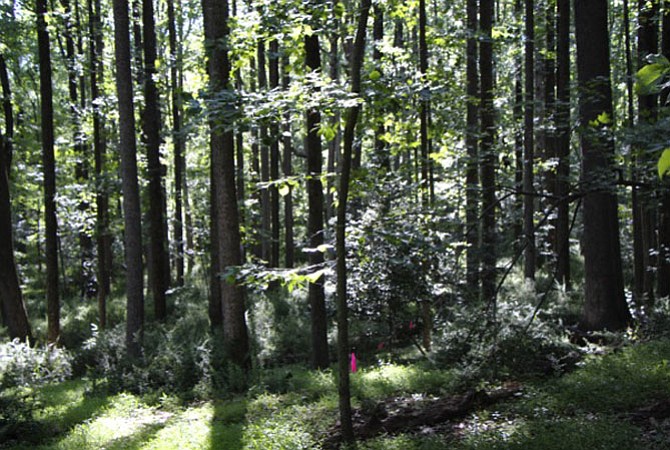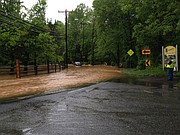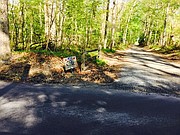Arthur Kingdom recommended that the Planning Commission come to the 11 acres of a potential development project to see sunlight coming through hundreds of mature trees. “It is idyllic,” he said. Photos contributed
Arthur Kingdom described sunlight shining through hundreds of trees on Challedon Drive, and the birds singing at sunrise.
“I hope members of this commission have had a chance to visit the forest in question,” said Kingdom.
“It is idyllic,” he told the Fairfax County Planning Board Commission.
Kingdom and his neighbor Zaheer Poptani sat on the opposite sides of an aisle in the Fairfax County Board Auditorium last Wednesday night, June, 29, indicative of the chasm between their points of view on the potential rezoning of 11 acres in Great Falls.
Poptani moved his property in 2011. “I asked what was going to go on behind my property,” said Poptani.
“It was always intended that something was going to be developed behind my house, it was not just possible but probable. I think this development will be a net positive for our neighborhood,” he said.
The Gulick Group applied to rezone the 11-acre property from R-A to R-1 in order to permit development of a 10-lot cluster single family subdivision at a density of 0.91 dwelling units per acre.
Fairfax County Planning staff have already recommended approval of the redevelopment.
“Staff finds that the application is consistent with the recommendations of the Comprehensive Plan and conforms to the requirements of the Zoning Ordinance. The requested waivers are supportable based on design details of the proposal,” according to the prepared staff report.
After two hours of testimony, last Wednesday, June 29, Dranesville Planning Commissioner John Ulfelder deferred the decision to July 21, 2016 to give Great Falls Citizens Association and Gulick Group an opportunity to further fine-tune details of the potential development; and to keep the public record open for additional feedback.
“I’m assuming there will be opportunity for GFCA and the applicant to meet further,” said Ulfelder.
“I hope there is ample time to discuss this development.”
ERIC KNUDSEN testified for the last time in his current term as president of the Great Falls Citizens Association.
“I’m standing in front of you, again, to try to protect one of the Great Falls assets, and the county’s assets, the environment,” said Knudsen, who last testified before the Board on Great Falls Citizens Association’s concerns with the redevelopment of Brooks Farm.
He reminded the Board that Great Falls, because of its location and environmental assets, like Potomac, Maryland, has a responsibility not only to the community, to the county, but also to the Potomac River watershed area and the Chesapeake Bay, and to protect the quality of the region’s drinking water.
“Storm water standards are set and although they are a step in the right direction, they aren’t doing what they intend to do. They are simply a band aid,” he said.
He told the Planning Commission that he used to ice skate on the lake on the property, known by some for the northern portion of the property which was permitted by rezoning in 1991 to be the Hill plant nursery.
“I ask you to postpone this decision until we can set up a proper settlement for how this community can be built, but also protects Great Falls’ interest, the Potomac River and the Chesapeake Bay,” Knudsen said.
“Can there be more cooperation with staff and the developer to get the data we were looking for?” he said.
BILL CANIS, the past vice president of GFCA, will now take the reins from Knudsen; Phil Pifer becomes the GFCA’s vice president.
Stormwater management will be a focus of the GFCA during the process with the Gulick Group.
“Our biggest concerns are the storm water management issues,” said Sandy and Sam Cappiello, neighbors of the Lexington Estates property.
“Anecdotally,” Sandy Cappiello said, in the spring after one of the community meetings regarding the property, emergency rescue had rafts to “rescue those in vehicles trapped by the flooding” on Walker Road.
“A single tree can absorb 100 gallons or more of rain. Gulick’s plan would remove more than a thousand trees. That would be more than 100,000 gallons of storm water added to the frequent flooding conditions that already exist in Great Falls,” she said.
THE GULICK GROUP seeks to develop the area, currently “undeveloped, forested, 11-acre parcel that is composed of moderate slopes that steepen towards the Piney Run floodplain,” said Planning Staff’s Bob Katai during the hearing that lasted until 11:05 p.m.
The floodplain and its adjacent slopes are identified as a Resource Protection Area and an Environmental Quality Corridor, according to Planning Commission documents.
“This site presents some challenges,” said Commissioner Ulfelder. “It gets steeper until it flattens out in stream bed in Piney Run.”
The Gulick Group seeks to build 10 single-family detached dwelling units, with lots ranging in size from 25,092 square feet to 35,110 square feet. An acre is 43,560 square feet.
Access to the development will be provided by an extension of Challedon Road, a public street.
Thirty percent of the property will remain open space.
The 11 acres are part of a 36-acre property rezoned by the Board of Supervisors, which approved a special exception at that time to permit a plant nursery on the portion of the property fronting Route 7.
“At the same time as the zoning actions, the 36-acre property was placed into an Agricultural/Forestal (A&F) District, which expired on Dec. 31, 2015. The plant nursery is no longer operational and the 36-acre property has been subdivided into several five-acre lots, with the subject property being the northernmost,” according to Planning Commission documents.
The 11-acre subject parcel is the northernmost portion of a 36-acre property which extends southwards across Piney Run and fronts on Route 7 (Leesburg Pike). The site is currently accessed from the north via Challedon Road, a paved Virginia Department of Transportation-maintained road. Challedon Road runs northward, to connect to Brevity Drive, which runs westward to connect to Springvale Road. There is a temporary cul-de-sac at the current terminus of Challedon Road.
GREGORY RIEGLE, of McGuire Woods, stood before the Planning Board to discuss the measures The Gulick Group has taken to address the concerns of the community.
For example, Gulick Group increased the range of the Environmental Quality Corridor and the Resource Protection Area.
“In all my years doing this,” said Riegle, “I can’t remember ... increasing the amount [of the RPA and EQC.] We did this as an opportunity to preserve more trees,” he said.
A list of proffers still being finalized represents working relationship between the developer and the community.
According to the staff report: “The proposed house sites avoid the steepest sloped areas of the site. The stormwater management system has been designed to convey, detain, infiltrate and distribute stormwater runoff in a manner that would minimize impacts to the site’s topography and vegetation.”
The community still has concerns.
“There has been talk of this development for a number of years,” said Kingdom. “I would scoff at the prospect because it is clear that water running down very steep, not moderate, slopes to a flood plain and then to a creek that runs to the Chesapeake is not suitable for development.”



